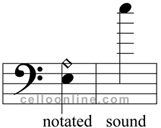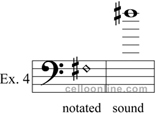Additional Cello Skills
| Notation | Name | Definition |
|---|---|---|
 |
Glissando | An ornamental effect notated as two notes connected by a wavy or straight line, indicating a continuous slide in pitch. Instead of playing the two notes separately, the finger should smoothly slide along the string between the two notes, playing all of the notes along the line in a subtle or pronounced manner (including the two notated notes). The context of the glissando should determine its interpretation. |
 |
Grace note | Used to ornament a note, a grace note is written in a small font indicating the musician should quickly play the grace note, then the note it is attached to (the grace note is not part of the rhythmic value of the measure). |
 |
Harmonics (natural harmonics) |
Harmonics are overtones of the string and produce soft flutelike sounds when the string is lightly touched at specific fractional divisions (nodal points). Natural harmonics are produced on open strings, and artificial or stopped harmonics are produced on stopped strings. Composers often indicate which string should be used for the harmonic by notating above or below the note markings such as sul D, D string, or III (meaning, play the harmonic on the D string, the third string on the violin).
Natural harmonics are indicated in two ways: by a small "o" written above the note to be lightly touched, and by a small diamond shape at a specific point on the string where the finger should be lightly placed. The most commonly used natural harmonics are described below, with notated examples on the D string.
|
 |
Harmonics (artificial harmonics) |
Artificial or stopped harmonics are produced by firmly pressing the first finger down on a note two octaves below the desired pitch, and then lightly touching the fourth finger a perfect fourth above the notated pitch. This divides the string into fourths, similar to example 3 in natural harmonics. The resulting sound is two octaves above the stopped pitch. Less commonly used, are artificial harmonics with a lightly touched finger a third or fifth above the stopped notes.
When artificial harmonics are notated, a small diamond shape is used to indicate the note that should be lightly touched. Ex. 5 is an example of an artificial harmonic on the D string, with the artificial harmonic a fourth above the notated pitch. To play it, firmly press your first finger down on the notated E, and lightly touch your fourth finger on the pitch A indicated by the diamond shape. The resulting sound should be two octaves above the stopped first finger E.  |
 |
Multiple stops | A collective term used to describe chords played on a stringed instruments. Specific terms for each chord include:
|
| con sordino | Muted | Play with a mute. Mutes are small clamps of wood, metal, rubber, leather or plastic, which fit onto the bridge and result in a softer, muted sound with a veiled quality. Muted sections of music are also indicated by the German term mit dampfer. The terms arco (bow), via sordini (take off mute), or senza sordino (without mute), are used to indicate when the muted section ends and the musician should resume playing with a bow. |
| ordinario | ord. | Ordinario or ord. means ordinary, and is used to indicate a return to ordinary playing after playing a special effect such as col legno or sul ponticello. |
| pizz. | Pizzicato (pizz.) | Indicates notes should be plucked rather than bowed. Violinists usually play pizzicato with their right index finger. To do this, they often place their thumb against the corner or side of the fingerboard to support the hand while plucking. A return to bowing is often indicated by the term arco. Less commonly used pizzicato effects are listed below. |
 |
Left hand pizz. |
Left hand pizzicato is indicated by the + sign placed over or under the note, and is sometimes used while the right hand continues to use the bow (it is generally played by plucking with the 4th finger of the left hand). |
 |
Nail pizz. | Nail pizz. indicates the player should use their fingernail instead of the fleshy part of their finger to pluck the string. The result is a metallic sounding pizzicato (this form of pizz. is difficult for violinists since they generally keep their fingernails short). |
| quasi guitar | Guitar Pizzicato | Guitar pizzicato is indicated by the term quasi guitar, meaning the violin is held like a guitar and strummed. |
 |
Pizzicato tremolo |
Tremolo notation along with the term pizzicato, indicates the player should use pizzicato tremolo. To do this, the finger moves up and down, rapidly plucking the notes for a tremolo effect. |
 |
Snap pizzicato |
In snap pizzicato, the string is plucked with such force that it snaps against the fingerboard when released. Snap pizz. is often called "Bartok" pizzicato, since the composer Bartok frequently used it in his string music. |
| Scordatura | Scordatura means abnormal tuning, and indicates one or more strings should be tuned higher or lower than usual (specific tuning directions for the new pitches are generally provided). | |
| Sul G Sul D Sul A Sul E |
Sul G means play on the G string and only the G string until otherwise indicated. In violin music, it is sometimes notated Sul IV or simply the numeral IV over or under the music, since G is the fourth string on the violin. Sul D (or III, the third string on the violin), Sul A (or II, the second string on the violin) and sul E (or I, the first string on the violin) also mean to play the notes on the single string indicated. | |
 |
Trill | A trill ornaments a note, and is a rapid alternation between two pitches, usually a major or minor second above the note. An accidental is often used to indicate whether the trill is a major or minor trill. |
 |
Turn | Turns are ornaments mainly used in music from the 17th-19th century. A turn generally indicates four notes should be played, encircling the notated note such as in the example provided: |
| Vibrato | Violin vibrato is similar to vocal vibrato—it is a slight and rapid fluctuation in pitch, and is used to add warmth and expression to music. There are three types of vibrato: finger, hand, arm or a combination of all three. Many violinists use a combination of finger and hand vibrato. This type of vibrato is produced by a back and forth rolling motion of the finger and hand on the string, resulting in the pitch being lowered and raised. Variations in the width and speed of the vibrato can produce a wide range of expression. The following definitions are excerpts from the renowned violin pedagogue Ivan Galamian's book Principles of Violin Playing and Teaching, pages 38-40, and explain the three types of vibrato in more detail:
Hand Vibrato: "In this type of vibrato, the hand swings from a more-or-less immobilized arm. The finger elongates itself as the hand swings backwards toward the scroll and then resumes its original curved position as the hand returns to its starting point." Arm Vibrato: "The impulse, instead of coming from the hand, now comes from the forearm, and, in this case also, the finger has to yield passively. The finger should be firm enough to hold the string down and to retain its place on the string, but flexible enough to submit to the motion of the arm. It must stretch and recurve with the backward and forward swing of the vibrato cycle." Finger Vibrato: "The impulse comes from the finger itself, which swings from its base knuckle with the hand slightly yielding and moving passively in flexible response to the finger action. This vibrato is smaller in width than the other types." |







